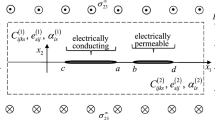Abstract
There are three types of cracks: impermeable crack, permeable crack and conducting crack, with different electric boundary conditions on faces of cracks in piezoelectric ceramics, which poses difficulties in the analysis of piezoelectric fracture problems. In this paper, in contrast to our previous FEM formulation, the numerical analysis is based on the used of exact electric boundary conditions at the crack faces, thus the common assumption of electric impermeability in the FEM analysis is avoided. The crack behavior and elasto-electric fields near a crack tip in a PZT-5 piezoelectric ceramic under mechanical, electrical and coupled mechanical-electrical loads with different electric boundary conditions on crack faces are investigated. It is found that the dielectric medium between the crack faces will reduce the singularity of stress and electric displacement. Furthermore, when the permittivity of the dielectric medium in the crack gap is of the same order as that of the piezoelectric ceramic, the crack becomes a conducting crack, the applied electric field has no effect on the crack propagation.
Similar content being viewed by others
References
Parton Y E. Fracture mechanics of piezoelectric materials.Acta Astronautica, 1976, 3: 671–683
Deeg W F. The analysis of dislocation, crack and inclusion problems in piezoelectric solids. Ph D Thesis. Standford University. CA, USA. 1980
Park Y E, hermann G. Conservation laws and the material momentum tensor for the elastic dielectric.Int J Engng Sci, 1986, 24: 1365–1374
Park Y E. Crack extension force in a piezoelectric material.J Appl Mech, 1990, 57: 647–653
Sosa H, Pak Y. Three dimensional eigenfunction analysis of a crack in a piezoelectric material.Int J Solid Struct, 1990, 26: 1–15
McMeeking R M. Electrostrictive forces near crack-like flaws.J Appl Math Phys, 1989, 40: 615–627
McMeeking R M. A J-integral for the analysis of electrically induced mechanical stress at cracks in elastic dielectrics.Int J Engng Sci, 1990, 28: 605–613
Wang B. Three-dimensional analysis of a flat elliptical crack in a piezoelectric material.Int J Eng Sci, 1992, 6: 781–791
Suo Z, Kuo C M, Barnet D M, Willis J R. Fracture mechanics for piezoelectric ceramics.J Mech Phys Solids, 1992, 40: 739–765
Dunn M L. The effects of crack face boundary conditions on the fracture mechanics.Engng Fract Mech, 1994, 48: 25–39
Hao T H, Shen Z Y. A new electric boundary condition of electric fracture mechanics and its applications.Engng Fract Mech, 1994, 47: 793–802
Park S B, Sun C T. Effect of electric field on fracture of piezoelectric ceramics.Int J Fract, 1995, 70: 302–316
Sosa H, Khutoryansky N. New developments concerning piezoelectric materials with defects.Int J Solids Struct, 1996, 33: 3399–3414
Zhang T Y, Tong P. Fracture mechanics for a mode III crack in a piezoelectric material.Int J Solids Struct, 1996, 33: 343–359
Kumar S, Singh R N. Crack propagation in piezoelectric materials under combined mechanical and electrical loading.Acta Mater, 1996, 44: 173–200
Gao H J, Zhang T Y, Tong P. Local and global energy release rates for an electrically yielded crack in a piezoelectric ceramic.J Mech Phys Solids, 1997, 45: 491–510
Tobin A G, Pak Y E. Effect of electric fields on fracture behavior of PZT ceramics.Proc SPIE, Smart Struct Mater, 1993, SPIE1916: 78–86
Park S B, Sun C T. Fracture criteria for piezoelectric ceramics.J Am Ceram Soc, 1995, 78: 1475–1480
Kumar S, Singh R N. Crack propagation in piezoelectric materials under combined mechanical and electricla loading: an experimental study. In: Adaptive Materials Systems. ASME, 1995AMD-Vol. 206/MD-Vol. 58: 69–83. American Society of Mechanical Engineering, New York, 1995
Anderson T L. Fracture Mechanics: Fundamentals and Applications. Boston: CRC Press, 1991
Author information
Authors and Affiliations
Additional information
The project supported by the National Natural Science Foundation of China (19672026, 19891180)
Rights and permissions
About this article
Cite this article
Hang, Q., Daining, F. & Zhenhan, Y. Analysis of electric boundary condition effects on crack propagation in piezoelectric ceramics. Acta Mech Sinica 17, 59–70 (2001). https://doi.org/10.1007/BF02487770
Received:
Revised:
Issue Date:
DOI: https://doi.org/10.1007/BF02487770



